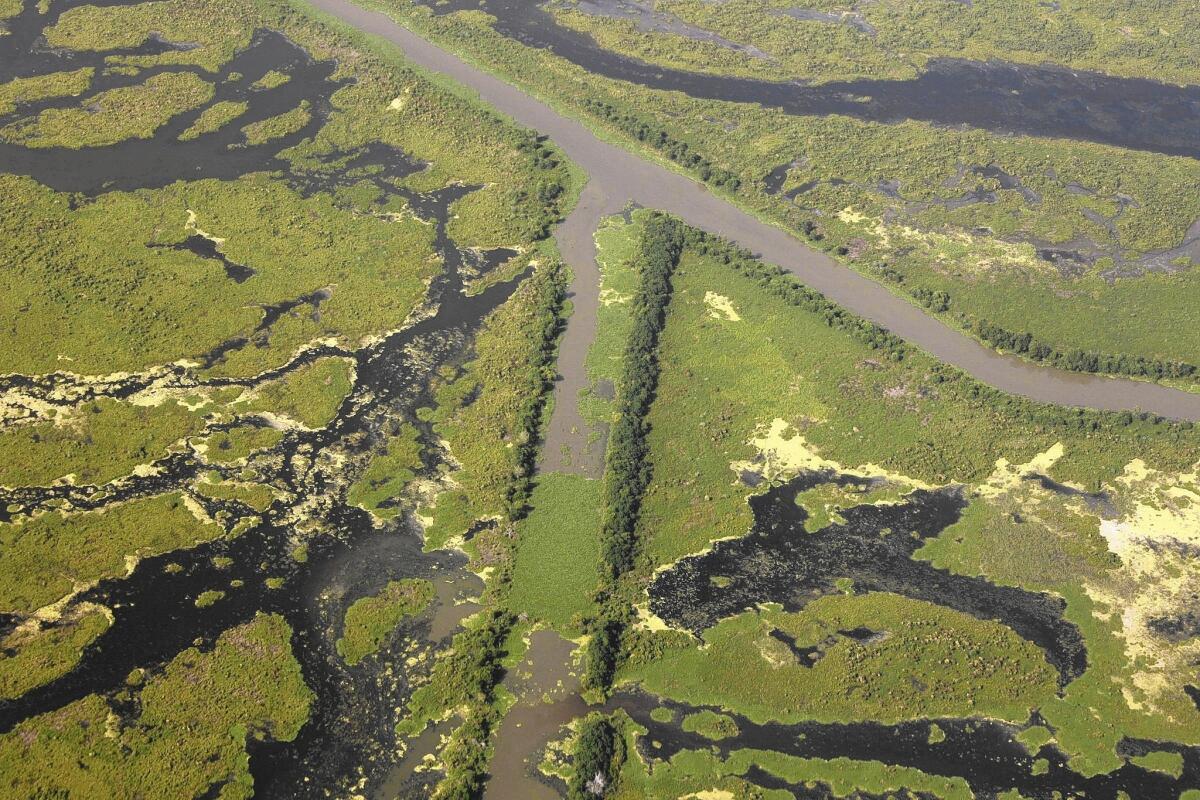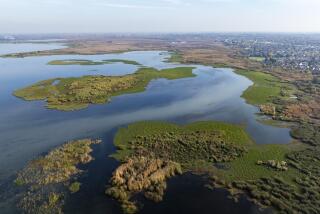Louisiana lawsuits seek oil and gas industry money to restore coastline

Every two weeks, a swath of Louisiana the size of this city’s French Quarter vanishes into the Gulf of Mexico. Since the 1930s, the state has lost nearly 1,900 square miles, a quarter of its coastal land area.
For decades, oil and gas companies cut canals through fragile wetlands with the state’s approval to haul equipment and install pipelines. But scientists say the dredging let salt water flow in, killing vegetation that kept the land from eroding.
Without the buffer of these marshes and barrier islands, Louisiana’s many low-lying coastal communities — and its biggest city — now have little natural protection from storm surges created by hurricanes.
The cost of rebuilding the defenses is estimated at $50 billion or more, but so far, there’s little money for it. Last summer, the independent board that oversees flood protection for New Orleans decided that oil and gas companies should pay their share. In a move that roiled a state where the energy industry is the economic foundation, the board voted unanimously to sue all 97 companies operating in the state for unspecified damages.
The lawsuit alleges that in “racing to extract the region’s resources,” the oil and gas industry built a canal network of more than 10,000 miles that is “a mercilessly efficient, continuously expanding system of ecological destruction.”
Aerial photos taken by the U.S. Geological Survey from Cameron Parish in the west to the town of Delacroix in the east show coastal areas before and after canals were dug for oil and gas production. The photos — one taken 50 years after the canals were built, another just nine years after — show vast stretches of open water where land had been.
In November, two southeastern parishes, Jefferson and Plaquemines, also sued companies that had dredged canals. Two other coastal parishes are considering lawsuits.
“We have been told for so long that the oil and gas industry is the hand that feeds us and that we are biting the hand that feeds us,” said Tim Doody, president of the Southeast Louisiana Flood Protection Authority-East, the nine-member board that oversees the levees in New Orleans and areas to the east. “But other places require them to be responsible businesses, and that’s all that I want.”
The cases are pitting those who believe the industry should be held to account for its role in the relentless coastal erosion against those who see it as a crucial business that has followed state laws in its shoreline construction.
The backlash from politicians has been swift and forceful. Republican Gov. Bobby Jindal and key legislators denounced the litigation, initiating legislation that would quash the lawsuits and undo post-Hurricane Katrina reforms aimed at removing politics from flood control. Last month, the state Senate passed a bill that would allow Jindal to kill the New Orleans lawsuit by replacing the lawyers who are handling it.
“I think it’s absurd to say that the oil and gas industry has damaged the coast. They did what they were told to do, and a lot of what they have done has helped us, not hurt us,” said Republican state Sen. Robert Adley, sponsor of a bill that would curb the flood protection board’s autonomy.
But the proliferation of lawsuits is a clear signal that the urgency of repairing the coast is changing how some in Louisiana see an industry the state has long embraced. Despite considerable pressure from the governor’s office, the flood protection authority, also known as the levee board, reaffirmed its litigation.
Over the next 50 years, the state is expected to lose as much land as it did in the last 80. The disappearance of the coast has left the state vulnerable to flooding from hurricanes, but it also affects the whole country. Nearly 90% of all offshore U.S. oil and gas production occurs off the state’s coast, and the industry’s infrastructure is stitched into the shoreline. The region is a hub for shipping and fisheries. The marshes attract millions of migratory birds annually.
Oil and gas infrastructure is not the only cause of the damage. Levees along the Mississippi River are the primary problem, preventing the river from depositing sediment in the delta. Subsiding soil and rising sea levels are also to blame. But canals account for up to 40% of the loss, according to scientists and the U.S. Geological Survey.
Gifford Briggs, vice president of the Louisiana Oil and Gas Assn., said most canals were dug before 1980 and authorized by the state, which has not found companies in violation of environmental laws. Briggs contends the flood protection board lacks the authority to pursue the suit and is being manipulated by “greedy trial lawyers.” He said, “They want billions of dollars, and our companies aren’t going to do it.”
The town of Violet, in St. Bernard Parish, is unlucky enough to be outside the huge flood walls built to protect New Orleans after Hurricane Katrina and is still flooded by storm surges. One recent evening, bartender Monique Verdin popped open beer bottles for about half a dozen mostly middle-aged men at De-Pope’s Boat Launch and Tavern. The owner, Lionel Alphonso Sr., is the self-anointed pope of the New Orleans Saints and has decorated the walls in black and gold fleurs-de-lis.
A member of the Houma tribe and a filmmaker, Verdin has seen the canals and the oil field pollution in pits next to her relatives’ homes. “I think it’s pretty revolutionary that people in Louisiana are talking about the oil and gas damage in a different way,” she said. “It’s not enviros and hippies. It’s businessmen and others who are saying, ‘This is not right.’”
Her customers were more wary. Like many Louisianians, the men work in the oil industry or have family who do and so declined to give their last names when discussing the industry’s effects on their community. One recently retired refinery worker said it was unfair to sue the oil companies because the state permitted the canals. But he was in the minority. The others held the industry partly responsible, noting that they reaped huge amounts of money from the state’s oil and gas.
The levee board contends it acted in part because the state cannot afford to fix the coast.
“We just don’t think you have the money,” said Gladstone Jones, the board’s attorney, at a testy January hearing held by Louisiana’s Coastal Protection and Restoration Authority. “The money and liability that these oil companies have: It’s laid out in black and white what they did, when they did it; there are aerial photographs of it.”
Garret Graves, then the authority’s chairman, took offense. “There’s a strategy. There’s money. We’re making progress,” he responded.
The state’s Coastal Master Plan, which would build levees and restore land, could cost at least $50 billion over 50 years. Louisiana is slated to get $1.2 billion from one of the lawsuits over the 2010 BP oil spill. Starting in 2017, it should get $140 million annually under the Gulf of Mexico Energy Security Act.
The Coastal Protection and Restoration Authority does not deny that oil and gas activity damaged the wetlands, but contends that the lawsuits would complicate a comprehensive restoration coastal effort.
State Sen. Adley and the Jindal administration’s other legislative allies have introduced at least seven bills to kill the lawsuits filed by levee board and parishes and bar new ones, as well as give the governor more control over the state’s levee boards.
Those boards were overhauled after Hurricane Katrina to insulate them from politics and populate them with scientists, engineers and academics. Since the lawsuit, Jindal has already replaced three members of the Southeast Louisiana Flood Protection Authority-East whose terms have expired.
The oil and gas association sued to stop the levee board lawsuit, but its case was thrown out in March.
The Rev. Tyrone Edwards of Phoenix, down the road from Violet, is the pastor of Zion Travelers Baptist Church. The tidy white clapboard church, along with the rest of Phoenix, was under more than 7 feet of water during Katrina.
Edwards, sitting in a pew of his low-ceilinged chapel, backs the lawsuits and brushes off the industry’s threats to leave, pointing out that it has billions of dollars of infrastructure.
“Sometimes you get into a battle you might not win, but your opponent might say, ‘I don’t want to fight him again,’ or ‘I need to settle things with him,’” he said. “It’s a fight we got to have because our survival depends on it.”
More to Read
Start your day right
Sign up for Essential California for news, features and recommendations from the L.A. Times and beyond in your inbox six days a week.
You may occasionally receive promotional content from the Los Angeles Times.







